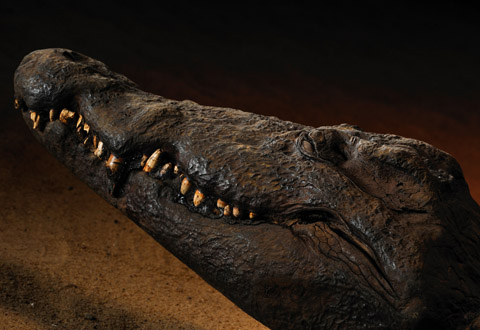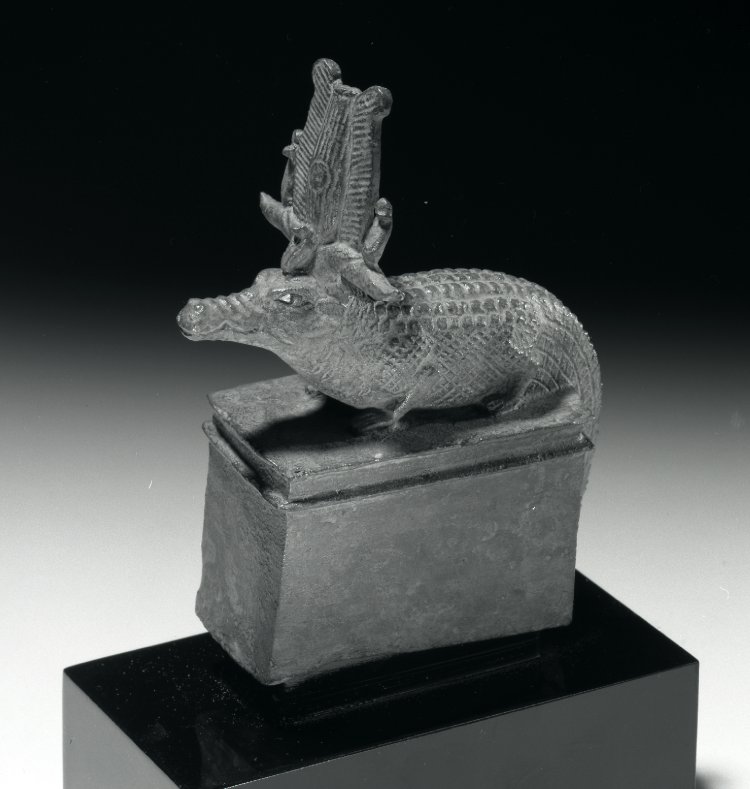The Rise of Sobek in the Middle Kingdom
Life in ancient Egypt focused on the vigorous inundation of the Nile and the land fertility it brings. So, it is not surprising to find these concepts manifested in Egyptian religion in the form of the crocodile god Sobek. Despite Sobek’s beginnings as a local deity, the god evolved to unparalleled prominence during the Middle Kingdom. His story during this period affected the politics of the time, demonstrated how ancient Egypt cultivated and blended deities, and marks a turning point in his role within the Egyptian pantheon.
The cult of Sobek was probably one of the earliest in ancient Egypt. He first appeared on a sealing from the reign of King Narmer, the first king of the first dynasty. The sealing shows crocodiles facing a distinctively shaped shrine that later became the symbol for the city of Shedet (modern-day Fayum). In the Old Kingdom, Sobek was established as one of the significant gods of Egyptian religion and was frequently mentioned in the funerary Pyramid Texts. Despite the occasional literary references to Sobek, his prominence at that time was focused on his cult center at Shedet.
After the demise of the Old Kingdom, Sobek appeared as a prominent local god at Sumenu, a locality in the Theban province. His cult there was present since the Heracleopolitan period when dynasties nine and 10 ruled Egypt from the Delta. This period came to an end when the Theban kings of dynasty 11 took control of Upper and Lower Egypt, beginning what is known as the Middle Kingdom. The cult of Sobek at Sumenu became the second most important after that of Shedet, especially during the reign of Amenemhat II.
However, it was not the appearance of Sobek’s cult in other provinces that made him important. That prominence came as early as the reign of Montuhotep II, the first king of the Middle Kingdom, when Sobek was merged with the sun god, Re. Such mergers of local and broader deities were not uncommon during these periods. Sobek-Re’s name first appeared at the entrance to the Theban tomb of Daga, an official during Montuhotep II’s reign. Even the Coffin Texts, the funerary texts used primarily during the Middle Kingdom, address Sobek as “he who rises in the east and sets in the west.”
By this merger, Sobek was no longer just a local god of inundation and fertility but the creator god through his association with Re. Sobek-Re, in his crocodile form crowned with the solar disc and uraeus (the symbolic cobra), became the creator who rose from the primeval waters, Nun, and formed the rest of the gods and the world. This role was frequently evoked in the cycle of hymns for Sobek, which were recorded during the late Middle Kingdom. Whether Sobek’s popularity led to his merger with Re or whether the merger was a political move by the priests of Sobek to gain power remains a mystery.
At Shedet, the new administrative capital of dynasty 12, the cult of Sobek saw yet another plot twist. Amenemhat II began to evoke an early dynastic, merged form of Sobek and Horus. Horus of Shedet was shown as a crocodile on a seal from the reign of Khasekhmwy of the second dynasty. Amenmhat II was the first to see this merge of Sobek and Horus of Shedet as the perfect syncretism to affirm the king’s divinity. But it was Amenemhat III who brought the role of “Sobek of Shedet-Horus residing in Shedet” to the highest significance.
Sobek-Horus of Shedet became associated with epithets like “Lord of the wrrt (White) Crown,” “he who resides in the great palace” and “lord of the great palace.” All of these epithets were related to the king rather than associated with any god. Even the name of Horus in this merged form was enclosed in a serekh like a king’s name. The king has always been identified as Horus on earth. With the new divine form of Sobek-Horus, the king as Horus merged with Sobek and incorporated himself as one with the god Sobek.
Sobek’s association with divine kingship is illustrated in the Amenemhat III’s “Baptism of the Pharaoh” scene at his Madinet Madi Temple in Fayum. This scene, the earliest of its kind, depicts Sobek and Anubis anointing Amenemhat III with ankh signs of life. The anointment marks the king’s initiation into eternal kingship and was usually related to the state god’s divine procreation of the king.
By the late Middle Kingdom, Sobek became known as “Sobek of Shedet-Re-Horus, the powerful god.” His cult spread to 52 towns across Egypt. Even the kings of the 13th dynasty preferred to include Sobek’s name within their own, as seen with the common royal name of Sobekhotep.
The Second Intermediate Period saw the end to Sobek’s fame. His cult at several towns remained, but he was no longer one of the state gods. Sobek’s importance to divine kingship resumed in the New Kingdom. Temples for him and Horus were built within the same precinct at Kom Ombo. Amenhotep III sponsored Sobek’s cult at Gebel el-Silsila, as well as at Dahamsha, Armant, where he established a divine crocodile breeding center.
Throughout these periods, Sobek rose from a local deity with limited significance to a creator god as Sobek-Re and a kingship divinity as Sobek-Horus. The kings of Dynasty 12, especially Amenmhat III, acquired a divine status not just as Horus on earth, but also by merging themselves with Sobek. Why did Sobek regain such importance? Was it the result of his earlier association with Re, or simply a plot by priests? Whatever the answer, the crocodile Sobek’s evolution seems the result of a cyclical process that offers a fascinating insight into the social and political backstory of Egyptian gods.


